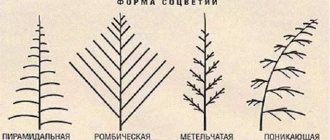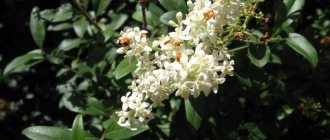Willow Goat pendula or, as botanists call it, Bredina, is an ornamental deciduous tree from the Willow family. This is a low plant with drooping flexible branches densely strewn with green leaves. Goats and sheep love to feast on the young leaves and shoots of the willow, hence the popular name for this variety of willow. Weeping willow fits harmoniously into any landscape design, decorating parks, gardens, and recreation areas around ponds. Willow is native to Europe, but it also grows in other regions. The weeping beauty can be found in Asia, the Caucasus, Siberia and the Far East. Growing a charming tree is not difficult, just follow all the tips for caring for the original plant.
Willow Goat pendula: description
Among the representatives of the Willow family, the Goat pendula willow is distinguished by its decorative properties. This is a deciduous tree with a luxurious tent-shaped crown. The crown size reaches up to 1.5 meters in diameter. This is a long-lived plant, on average the plant lives 30 years. Its growth is rapid, every year it grows by 5-10 cm in height, becoming 10-20 cm wider. Willow retains its decorative effect throughout the year. In spring, the spreading long shoots are dotted with fluffy catkins, which are popularly called “seals”. From May to September it decorates the area with a luxurious green crown, and in winter the tree, with drooping dark branches, looks touching against the background of the fallen snow.
Botanical characteristics of willow Goat pendula
- Branches . Thanks to its thick, spreading and drooping shoots, the tree looks luxurious. The bark of young shoots is colored gray-green, then it acquires an olive color. The bark of old branches becomes grayish in color and they become brittle.
- Leaves . Dense dark green foliage densely covers the shoots. Goat willow castings have an oval, slightly pointed jagged shape. The leaves are smooth on the outside and slightly velvety on the inside. Flower buds are located in the axils of the leaves.
- Earring flowers . The plant blooms in March-April for about 2 weeks. In early spring, catkins of both sexes bloom: female and male. Women's earrings are multi-flowered, dense, painted in a golden-yellow hue. They have an oval shape, stretch up to 10 cm in length. Male earrings are pressed tightly to the branch, their length is no more than 6 cm. The plant is an excellent early honey plant. The pleasant aroma emitted by the flowers is attractive to numerous insects, including bees. After pollination, a capsule fruit is formed.
- Fruit . The diameter of the fruit in the form of a box reaches 7-8 cm. Inside the box there are 16 - 18 seeds on fluffy elongated legs. Seeds have low germination.
Grafting standard roses
Standard roses differ from ordinary bush types in that their branches with lush inflorescences of buds are located on top at a height of more than 200 cm, and do not start close to the ground. These queens on a pedestal stand proud of their greatness over their relatives. In order to enjoy standard roses, you don’t need to bend down, but just come up and connect with the beauties. It’s not for nothing that every rose fan definitely wants to grow a standard rose.
with your own hands. After all, what joy and pleasure you get from your work. If you buy any seedling, you will value it as highly as the one you propagated by grafting yourself. In addition, I would like to note that the standard can be multi-colored, since it is possible to grow 2-3 varieties on it at the same time.
You can grow a standard rose with your own hands using a propagation method such as grafting or budding
. Grafting roses onto a standard consists of having a rootstock and a scion. Bush varieties of “queens” are much easier to propagate than standard ones. The fact is that standard roses take twice as long, about 3-4 years, than the bush varieties we are used to. The difficulty of grafting standard roses lies in growing a rootstock of optimal growth, quality and thickness from rosehip seeds or seedlings. If bush vidi is bred for 1-2 years, then for standard rootstock - 3 years. Perhaps, after reading the above, you will give up and say that this is not for you, because 3 - 4 years is a significant period of time in order to get a standard seedling. But worry about it. Grafting standard roses is within the power of everyone. You don’t have to wait that long, you can just take a closer look at your flowerbed and see the rosehip bush into which the rose you once bought has been reborn. Even a bush that didn’t survive the winter a year ago, but you didn’t want to throw it away, will do, and in its place a fragrant rose hip grows. It also happens that you once tried to graft some variety, but it did not take root and uncultivated shoots grew there. This option is also suitable for your experiments. The quality of such standard rootstocks will be somewhat lower, but you will still get a rose on a pedestal. What to do next you ask? It is advisable to dig up the trunk before grafting in the fall and replant it in a permanent place, which is located higher (so that there is no stagnation of autumn or spring melt water), protected from strong northern winds and well lit during the day. At the same time, try to preserve branched roots. The prepared seedling is pruned, leaving 1-2 stems that extend from the base of the bush, cutting out skeletal shoots in its center. Pruning can be done with garden pruning shears or a saw. Try to make as few cuts as possible. This sample for grafting roses onto a standard should be covered for the winter, since the young branches are not mature enough for wintering. You can find out how to do this in this article. You can carry out the planting procedure in the spring, before the rosehip buds break. Planting standard roses was discussed in previous articles.
The yield of stems from the grafting of ordinary non-varietal wild rose hips does not exceed 45%. In specialized nurseries, high-quality and long-lasting trunks of the rootstock - rose hips - are bred from seeds. This plays an important role in helping the bush serve you for many years. That is why vigorously growing forms of rose hips are carefully selected to ensure high agricultural technology for growing seedlings. The main features that a rose hip should have are a strong root system, good winter and drought resistance, high resistance to diseases, durability, good growth, hard, flexible wood with a small core, absence of root and stem shoots, a limited number of thorns and, most importantly, , good growth with cultivated varieties of roses and good development of their branches. Dog rose or canina rose (Rosa canina) has these features. The grafting yield of such specially grown wild rose hips is 80%. You can also use vigorously growing forms of rose hips (Rosa rugosa) in grafting standard roses, but they will serve you less well. Cinnamon rose (Rosa cinnamomea), rubiginosa rose (Rosa rubiginosa) are not suitable for rootstocks, since they have a significant amount of shoots, branches are densely covered with thorns and have moderate growth. It should be remembered that the standard for grafting must first of all be young, that is, about 1-2 years old. Its age can be easily determined by looking at the stems. In 2-year-olds, on top, several side shoots have a slightly rough gray bark, and in one-year-olds, the branches do not have branches, and the bark is mostly green or red-brown. It is important that the bark of the trunk when grafting is thin and not coarse, in order to better perform the procedure.
Among the rosehip seedlings, strong annual plants with a root collar with a diameter of 8-10 mm are selected and carefully planted in the fall in a prepared area with a distance between plants in rows of 30 cm and row spacing of 1 m. Without pruning with normal care for 2-3 years, the standard rootstock for grafting, it will develop long lashes up to 1.5-2 m. To form a standard rose, take an annual shoot grown from a dormant bud in the center of the bush. Some gardeners carry out a strong pruning of the above-ground side in the spring of the 3rd year, leaving one stump, thinking that it will stimulate the development of replacement shoots. However, this is not the case. The bush will throw out young stems from dormant buds at the base, which will compensate for the lack of air nutrition by branching, retarding growth. In this case, low quality of the plant will be observed, even if the side shoots are systematically cut off. What to do then? In the spring of the 3rd year, we partially cut off the trunk prepared for grafting, cutting out all last year's unbranched restoration shoots growing at the base, leaving others. If you do this, then thanks to the upper growth point, replacement shoots will be 1-7 pcs. will grow all season. Of these, we select 1-2 strong, tall and straight shoots (from 80 to 200 cm) in August, the rest are cut out or dug up at the root collar, and the tops are grafted, causing the wood to ripen more quickly. We make cuts with pruning shears or a saw, covering them with garden varnish. The fewer cuts and damage, the better the standard for grafting. The best trunk (smooth, flexible, long, extending from the base) is suitable for grafting standard varietal roses. Depending on its height, standard varieties are divided into categories:
- long weeping (cascading) (1.2-2 m);
- medium standard (0.9-1.1 m) and semi-standard (0.7-0.8 m);
- low miniature (0.4-0.5 m).
The rootstock, that is, the standard for grafting, is planted vertically in a permanent place next spring (for reliability) or autumn. The roots are trimmed and placed evenly in the hole so that they are not compressed by its walls. The hole should be fertilized with humus, peat and have a little clay. We place the root collar and the beginning of the trunk in the ground. The support is installed not in the first year, but the next.
Grafting standard roses
Grafting of standard roses in Russia (Moscow) is carried out in the same time frame as for ordinary bush species, that is, in the spring, around May, or in June. In warmer regions of our country, roses can be grafted onto a standard earlier (per month). However, it is best to carry out budding (grafting) in the second half of summer (August) and early autumn (September). In August, in the rootstock - trunk, the bark lags behind well when cut. If this procedure is carried out, it makes no difference either in the spring or in the summer, then the tissue of the scion and rootstock will germinate well and have time to become woody before the arrival of winter. Graft a cultivated variety of rose onto a standard
much easier than the bush variety, since the grafting site is high above the ground and there is no contact with the soil, which is a big reason for the cuttings to germinate. Failure to comply with hygiene during budding is the cause of the death of the sprout. If there was dry weather before the grafting procedure began, the trunk should be watered abundantly two weeks beforehand. If the operation to engraft a variety fails, it can be repeated the same year or the next, taking into account the condition of the bark (thin, not rough, normal sap flow). The fact is that in the upper half of the stem the sap flow stops earlier than in the root collar. Thus, grafting a standard rose needs to be done faster than a bush rose. Repeated grafting (if the first one fails) on the standard should be slightly lower than the old budding.
The most popular method of propagating roses is grafting (budding) a petiole or bud, shield, eye with or without part of the wood into a rootstock - standard. A well-known method is to graft the variety into a T-shaped cut; less traditional is the method of budding into the butt under the tongue, into a cut or split.
To graft a standard rose, you need 2 elements - one long shoot of rose hips (standard or rootstock) and 2-3 buds (eye) with or without a shield of bark from a varietal rose. Many publications say that the best survival rate of a cultivated variety is observed when wood is removed from the shield. However, in my opinion and experience, I do not recommend pruning the tree in the same way as when following the advice of publications, the shields did not take root for me.
For grafting a standard rose, the bud is located in the middle part of the stem, since there are flower ovaries there, and the first three leaves from the bud do not contain them. Taking a shoot from any bush, we cut out a peephole in the middle with a leaf petiole and bark in a thin layer, 1-1.5 cm long. It is also called a shield. We cut 2-3 such shields. Cuttings with eyes are prepared in advance or previously prepared ones are used, wrapped in cloth or film in the refrigerator. For the shield, faded shoots with sprouted (if you break off the sprout first) or non-sprouted buds are suitable. It is better to use fresh cuttings. It is better to carry out budding in the morning, shading the grafting site. Standard - the rootstock is washed and wiped before grafting, and a T-shaped cut is made on the bark on top (depending on its height). How to make such a cut? We first make a transverse incision of about 1 cm, and then a longitudinal one. Use a special budding knife. When cutting the bark, do not remove the knife, bend its left and right edges with it, insert the shield there, hold it with the help of a leaf petiole. If the shield does not fit completely into the cut, then the excess part is cut out. When grafting standard roses, it is forbidden to touch the cut site with your hands.
After inserting the eye, the bark of the rootstock is pressed and wrapped with pieces of polyethylene film (you can also use PVC tape, also insulating plastic), 20 cm long and 0.5-1 cm wide. Once upon a time, the shield was even wrapped with sponge, raffia and cut into narrow strips bandage. This way you will combine the wood of the trunk and the shield of the varietal rose, which will immediately come into contact with each other. We wrap the film in rings tightly from top to bottom of the shield so that the peephole is visible. Some apply the film too tightly that even the peephole is barely open. If you use insulating plastic, then place it on the grafting site with the non-sticky side, and then turn it over at the end onto the sticky one.
In 2 weeks, or even 1 month after grafting a standard rose, it will be clear whether the shield has taken root or not. If the operation is successful, you will notice that the bud will begin to thicken and the leaf petiole will fall off when touched. Failure to graft a rose onto a standard will result in drying out and blackening of the buds, but re-budding can be done. Standard roses are grafted from two (in Europe from 3) opposite sides at a distance of up to 5 cm above the crown. If you plant varieties at the same level, in one direction, then they will crowd each other during growth and some of them will disappear. It is believed that budding 2 eyes on a standard rose will be quite enough to form a lush, uniform crown. Grafting one bud will not be optimal, as the crown will be poor. Nowadays in Europe it is practiced to graft 3 eyes per standard. Depending on the height of the standard rootstock, a different variety of rose is grafted to that height. At high heights (about 1.5-2 m) they bud ground cover, climbing plants at a height of 1.4-1.6 m. At medium heights - floribunda, hybrid tea, polyanthus, grandiflora at a height of 1-1.2 m. At low heights - patio border roses, spray roses, miniature roses at a height of 0.5-0.8 m. Standard roses are grafted, in principle, from one variety, although different types and colors are possible. The main thing when grafting onto a standard is to choose the right scion with the same growth vigor and habit. Otherwise, the strong one will oppress the weak one. Shoots that are located above the specified location can grow freely. In total, the crown of a standard rose is formed - 3-5 lateral shoots; if there are fewer of them, then normal movement of sap will not occur.
During the process of vegetative growth, it is necessary to systematically remove (dig up and cut out) the wild growth at the base.
The trunks can be grown in another way. A rose hip bud taken from the central part of the shoot is grafted into the root neck of the rootstock. One strong stem grows from this bud. The remaining shoots, which also appear at the grafting site, are cut out. The standard obtained during such budding is grafted with a varietal rose. It is advisable to take the rootstock for intermediate grafting from vigorous rose hips.
I hope that after using the recommendations in this article you will be able to successfully graft a standard rose. The main thing is to be patient and enjoy every stage of the operation and everything will work out as it should.
https://rozaibuket.ru/privivka-shtambovyx-roz/
Choosing a place to plant willow Goat pendula
The ornamental tree takes root well in well-lit, sunny areas, but can also grow in the shade of taller trees. Afraid of drafts and strong gusts of wind that can break branches. Prefers fertile, loamy soil with good drainage. Since the willow root system is superficial and subtly reacts to excessive soil moisture, when planting a seedling it is necessary to take care of a good drainage layer. The crown grows quickly, so the area where the tree will grow must be spacious.
Care Tips
Caring for willow is completely simple; it consists of the following activities:
- Watering is one of the most important measures for caring for whole-leaved willow, especially if it is planted in an area that is not sufficiently moistened. Young plants are watered regularly throughout the summer; if there is a drought, old plants can be watered less frequently, but more abundantly. If the weather is hot and dry, then you can sprinkle the crown, but not in bright sun, so as not to burn the leaves. In the heat, willows feel very good near bodies of water, where the air is still more humid. When planting, give preference to damper places, since the root system of wholeleaf willow can withstand short-term flooding better than constant drought.
- Trimming. Whole-leaved willow, like all its relatives, tolerates pruning well. Early spring pruning has a good effect on the formation of a bush, which becomes denser. Formative pruning can be done throughout the summer, especially for standard species, in which the crown is maintained in a certain shape. The fact is that some varieties of whole-leaved willow give large seasonal growth, reaching 30 cm per year, and if regular pruning is neglected, then by the end of the season the crown will be overgrown. In addition to the loss of aesthetic appearance, this also threatens its damage during heavy snowfalls in winter. Sanitary pruning is carried out in the spring. It consists of removing all frozen and damaged branches.
- Fertilizing is carried out 1-2 times per season with organic or mineral fertilizers; on fertile soils, fertilizing can be reduced to once.
- The tree trunk circle is cleared of weeds and loosened; you can also use mulching, or plant low-growing plants that will protect the soil from excessive drying.
- Preparing for winter. Although the whole-leaved willow is quite resistant to frost, in the coldest winters it can freeze to the level of snow cover. Therefore, young plants in the first years of life can be covered with any breathable material, or covered with leaves and sawdust. With standard forms they sometimes do the same thing as with standard roses: they are tilted to the ground in several steps and covered.
It is also worth paying attention that the willow planting site is not in a place open to northern winds, which are more dangerous for it than frosts because they completely dry out the young branches.
How to choose a high-quality willow seedling Goat pendula?
The attractiveness and rapid growth of ornamental crops largely depends on the quality of young seedlings. You can buy goat pendula willow seedlings in nurseries. When choosing a quality seedling, you should adhere to the following recommendations:
- First of all, you need to find out by what method the seedling was obtained: grafting to a trunk or pruning.
- If the seedling was grafted onto a trunk, take a closer look at the grafting site. There should be no dead, dry scales on the trunk bark.
- Choose a young, healthy-looking tree with a straight and strong trunk, without damage.
Tree pruning
Goat willow care is not complete without proper pruning. It is this that gives the crown a decorative appearance and splendor. In the first few years, you need to cut off all the branches, leaving a length of no more than 15 cm. At the same time, make sure that there is a bud at the end, looking up and to the side, not inside the crown. This will help the tree to develop properly and form a lush umbrella of trimmed shoots.
This type of branch pruning is called candelabrum pruning and is suitable for experienced gardeners who are well versed in their craft.
Pruning must be carried out according to the rules. Do it in early June, as soon as the plant stops blooming. If you shorten the branches in the fall, next year the Goat pendula willow may not bloom and not please you with a chic golden look.
Beginning summer residents can simplify the procedure and care for the crown throughout the summer. Monitor the growth of young shoots and pinch them, that is, remove the apical buds as soon as the branches reach a length of 15 cm. This pruning awakens the lateral buds, and the crown grows lush and symmetrical.
Willow Goat pendula: planting
Seedlings are planted in the spring, when the soil is already warm enough, or in the fall. This is the optimal period for the young tree to take root. Before planting, young seedlings are placed in water for several days. The roots should not be dry before planting.
Planting of seedlings is carried out according to the following scheme:
- The size of the planting hole for planting willow should be 0.5 meters wide and 0.4 m deep.
- To prevent rotting of the surface root system, a drainage layer is laid at the bottom of the hole, which will not allow water to stagnate. Willow does not respond well to excessive moisture in the soil. For drainage, small pebbles and expanded clay are placed at the bottom of the pit.
- Fill the planting hole with a soil mixture, which is previously prepared from peat, humus and compost, taken in equal proportions. If necessary, if the soil mixture turns out to be heavy, add 20% dry sand.
- To enrich the soil with nutrients, add about 200-300 grams. mineral fertilizer.
- A willow seedling is placed in the center of the hole, covered with earth and compacted.
- After planting, the seedling needs abundant watering. Under one tree you need to pour 1-2 buckets of water.
Reproduction technology
Goat willow seeds.
Goat willow can be propagated by grafting, seeds, cuttings and layering.
The cuttings take a long time to form roots. Most often, planting material disappears. It is necessary to cut off non-lignified shoots in late autumn. The length of the stem should be about 20 cm. It is recommended to use a side cut. In the cold season, you need to place the cuttings in a container with clean sand or a damp bag. In spring it is necessary to plant shoots at a distance of 15 cm.
At least 3 buds should remain on the soil surface. It is necessary to regularly maintain the substrate moisture. Subject to careful watering and feeding, the plant can grow 1 meter in one season.
Cuttings of delirium.
To grow from seeds, you need to find high quality seed material. The seeds can remain viable for one month. The first shoots may appear (under favorable conditions) within a few days.
Goat willow on a trunk looks great on alpine hills and rockeries. For propagation you will need a wild representative of the willow (rootstock) and one of the varieties of “Creeping”, “Wholeleaf”, “Red” or “Shaggy” willow. A willow on a trunk can reach about 2 meters.
Willow Goat pendula: care
A young willow tree needs sufficient care in the first year after planting, which includes the following activities:
- Watering . Particular attention must be paid to watering the plant, since the root system requires good moisture. The tree is watered 2-3 times a week. In dry and hot summers, the amount of water for irrigation is increased. Willow loves water treatments, so it will appreciate watering the foliage once a week.
- Loosening . A day after each watering, the soil must be loosened so that cracks do not form in it.
- Mulching . To maintain a sufficient level of moisture in the soil, the area around the tree trunk is sprinkled with a layer of mulch. A layer of sawdust, expanded clay, small pebbles or dry grass will prevent the soil from drying out and will also protect the plant from weeds.
- Feeding . To make the crown of the weeping beauty look luxurious, you need to feed it at least 2-3 times (from spring to autumn) with complex fertilizer. Experienced summer residents use potassium sulfur or superphosphates as an effective fertilizing.
- Preparing for winter . The plant is frost-resistant and tolerates cold winters well. But young, not yet strong trees, less than three years old, need careful shelter from severe weather. The trunk of the tree is wrapped in fabric or covering material.
Salix integra Hakuro-Nishikionshtambe
Synonyms: Salix Integra on shtambe, Japanese willow Hakuro-Nishiki on shtambe, Salix Hakuro-Nishiki, Willow Hakuro-Nishiki on shtambe.
Form: Japanese willow Hakuro-Nishiki on a trunk - a small tree, a clipped ball of Japanese willow Hakuro Nishiki on a trunk with an umbrella-shaped or spherical crown. The branches of this plant are slightly vertical, but over time, as they lengthen, they take on a slightly fountain-like appearance; in winter they have a bright red hue. It is one of the smallest members of the willow family, grown in tree or shrub form. It is a type of willow that comes from the northeast side of China, Japan, and Korea.
Height / diameter: the size of the Japanese willow Hakuro-Nishiki depends on the height of the trunk, but the crown in diameter can reach 2 m or more.
Leaves: Long narrow leaves cover the graceful branches, showing the grace of the bush, as well as the variety of colors of the young pink leaves, later white-green, which will turn yellow in the fall and fall quite late, perhaps in October-November.
Flowering: catkins appear just before the leaves appear.
Bark: Shoots dark red-brown, bark gray-green, gray with age.
Root system: superficial, tolerates planting near the trunk.
Relation to light / insolation: Willow is an unpretentious plant, but for its vigorous development it requires a lot of water and light.
Type of soil/soil: Tolerates all normal garden soils, prefers fresh, moderately moist, sandy-clayey soils, from slightly acidic to slightly alkaline, begins to shed leaves earlier on light soils, avoids high lime content.
Planting/care: It is better to buy Japanese willow seedlings Hakuro Nishiki on a trunk, grown in Ukraine with a large lump in burlap, so the plant is guaranteed to take root after planting. All plants purchased from the PROXIMA nursery are provided with long-acting fertilizers with the latest formulas from the best European manufacturers and can be sold in your garden center without additional fertilizing for a whole year. But the greatest advantage of buying potted plants is that they can be planted, without buying additional fertilizer, from March to December - even on the hottest days of summer.
Hakuro-Nishiki willow requires minimal pruning. Remove any broken, diseased or unwanted branches in late fall or winter. It also requires regular removal of lawn grass from the tree trunk and mulching with a thickness of at least 7 cm. Feed with granular long-acting complex fertilizer in early spring. We fertilize as usual with balanced NPK + Me in the spring - nitrogen, in the summer - phosphorus, August - September - potassium. Do not forget about improving the soil structure with organic matter (humus, compost), and regular foliar treatments with mineral and organic fertilizers with adhesive. When new young growth appears on a willow trunk, we advise you to remove it immediately.
Pests and diseases: Japanese willow Hakuro Nishiki on a trunk is resistant to pests and diseases. An untreated plant can be affected by powdery mildew, green leafworm, fruit cap moth, necrosis of branches and trunks. To protect the plant from diseases and fungal infections, it is necessary to treat the plants with fungicides (Skor, Switch, Maxim, Ordan, Horus, Quadris, Radomil Gold, etc.). Of course, it is better to have a specialist make the “diagnosis”. But, as a rule, a modern gardener, using the Internet, can independently identify the enemy and choose the right methods and means of protecting the plant. To protect the tree from the pest, preventive spraying with insecticides (Aktara, Enzhio, Aktellik) is carried out in the spring. Compared to the voracious larva of the May beetle, other pests are rare on a well-groomed plant. Over the past 10 years, Khrushchev, especially on humus-rich, weed-free soils, has become the most dangerous pest of garden plants in Ukraine. One beetle larva can gnaw the root system of a young 10-30 cm seedling in 1 day, completely destroying it. From mid-April, when we see the first flying beetle, we URGENTLY treat the crown with any of the numerous preparations based on imidacloprid, for example Prestige (Bayer), Antikhrushch, while part of the solution must get onto the trunk (10 cm above the ground) and the root collar and not spill to the side . We repeat similar treatments every 40-50 days of the growing season. We pour it into the soil according to the instructions, Aktara is also effective (active ingredient - 240 g/l thiamethoxam; 250 g/kg thiamethoxam). Treatment along the crown and topping up the root collar into the soil from late April to September once every 40-60 days.
Application: Willow Hakuro-Nishiki on a trunk is a wonderful tree for your garden. Standard plants have been known for quite a long time, many of them have a history of centuries or more. Standards mark the entrance to a house or veranda and are installed in the center of paved areas. Recommended for small gardens and mixed compositions. Willows look amazing on a trunk in topiary gardens and alley plantings. Japanese willow Hakuro-Nishiki is perfect for landscaping parks and gardens in single and group plantings, near ponds, as a tapeworm, or can even be planted in a pot on the patio. If you constantly remove thick branches, giving the opportunity for the growth of young shoots, then the plant with its variegated white-green leaves takes on the chic appearance of a large dandelion. Also, the bright red branches of the Hakuro-Nishiki willow look colorful in winter.
Advantages: Improves the soil and atmosphere, serves to strengthen banks, embankments, erosion ravines and cliffs. Spectacular decorative earrings will delight you in early spring even before the leaves appear. Adds brightness to the color palette of your garden both in summer and winter.
Climatic zone/frost resistance zone: 4. Somewhat sensitive to late frosts, but at the same time absolutely stable throughout Ukraine, wind-resistant.
buy Japanese whole-leaved willow Hakuro-Nishiki on a standard in Kiev at low prices in the PROXIMA plant nursery.
Read more about planting, watering, care, fertilization, protection - with photos in the “Planting, Care” section.
proxima.net.ua
Willow Goat pendula: pruning
An important stage in caring for a weeping beauty is timely pruning of young branches. Shortening the shoots will allow the tree to maintain its decorative appearance and give the crown a luxurious tent-like shape.
- In the first year of a young willow’s life, you need to cut off all long shoots up to 15 cm, leaving one healthy bud on each branch. The kidney should be pointing upward.
- The pruning procedure is carried out annually after flowering. In adult specimens, the stems are cut to 2/3 of their total length. Over the summer they manage to stretch out, creating a thick, drooping crown.
- After wintering, the tree needs sanitary pruning, in which all dry, broken and weak branches are removed.
Rules for planting and care
Even a novice gardener can handle planting and caring for the Hakuro Nishiki willow. This is a fairly unpretentious variety that can be replanted in adulthood. The main thing is to choose the right place to plant young bushes, and they will feel good and grow quickly. In addition, it is necessary to prune the willow of Hakuro Nishiki in order to form the correct crown of a rounded shape.
Preparing seedlings and planting them in open ground
Willow is native to Japan, but it has adapted well to a temperate climate with temperature differences between winter and summer. Like other willow varieties, this variety prefers moist soil. The optimal place for planting seedlings is the banks of natural or artificial reservoirs. Otherwise, it is necessary to constantly monitor the level of soil moisture and prevent the bushes from drying out.
Hakuro Nishiki willow propagation occurs in two ways:
- cuttings - they are harvested in early spring, after which they can immediately be planted in open ground;
- grafting onto other trees is the main technology for creating Hakuro Nishiki willow on a trunk.
The main method of propagating willow at home is cuttings. Cuttings are sections of branches that are taken from adult bushes in early spring. The most important thing is to have time to get them before the beginning of the growing season, so as not to harm the mother plant. The cuttings do not require preliminary preparation: just slightly dry the cut area and lower it into the soil. During the warm period, the seedling will take root and begin to grow. The bushes begin to bloom approximately in the third year of life.
Planting and caring for the whole-leaved willow Hakuro Nishiki is possible at home. Another way to obtain unusual trees is stamping. A standard is a tree with a strong, even trunk, onto the top of which Japanese willow is grafted. Most often, goat willow, which has a tree-like straight trunk, is used for these purposes.
Tree care
Planting and caring for the Japanese willow Hakuro Nishiki does not take much time. It grows well without additional fertilizers and daily watering, if you choose the right place to plant the bushes. There are some rules thanks to which the willow will grow tall and healthy:
- the plant tolerates stagnation of moisture better than drying out of the soil, so it should be watered constantly;
- for planting it is better to choose a place with a high groundwater level;
- For fertilizing, you can use organic fertilizers - compost or humus;
- To prevent fungal diseases, the leaves are sprayed with fungicidal agents:
- It is better to take seedlings from bushes in the region in which they are planned to be planted - this way they will quickly adapt to climatic conditions.
The willow variety Hakuro Nishiki, like other representatives of the willow family, prefer well-lit areas. It can also grow in partially shaded areas if exposed to bright sunlight during the day. In the dark it grows slowly and its leaves appear weak. Willow is unpretentious to the type of soil. However, if you plant it on clay soil, you should add sand or peat to it for better moisture conductivity.
Japanese willow is resistant to temperature changes and easily tolerates winter frosts. If the frost is severe, some shoots may freeze, but this does not harm the entire bush. Such branches simply need to be cut off during the first spring pruning.
Crown trimming
Since this willow variety is a bush with long, even branches, their growth can be adjusted. With proper and timely pruning, the plant looks thick and lush. This process also has its own characteristics:
- the first formative pruning is carried out in the spring, before the beginning of the growing season;
- do not be afraid to cut off excess shoots - the bush quickly restores its shape due to the growth of new ones;
- in the first year, no more than 4-6 buds are left, each year adding 1 bud to this length;
- At the end of autumn, the last pruning is carried out, during which dry or diseased branches are cut off.
As a result of competent work with the shape of the crown, the willow becomes like a ball. If it grows on a trunk, the tree resembles a huge dandelion. It is also necessary to trim off excess shoots along the trunk of the standard tree.
Reproduction of willow Goat pendula
There are 2 methods of propagation: grafting onto a standard and cuttings.
- Grafting onto a standard is a long process that requires certain knowledge and skills. Shoots grafted onto a standard often do not take root. A tree with a weeping crown that hangs onto a smooth, bare trunk (trunk) looks attractive and is used in landscape design. To maintain the decorative appearance of the crown, regular pruning of shoots is required.
- Cuttings from shoots is an easier method of propagation. Held in early spring. Select lignified shoots, at least 40 cm long, and place them in water for several days until buds appear. Then the cuttings can be planted, not forgetting to regularly water the seedling.
Beauty and form
Goat willow in landscape design (photo can be seen below) is very common. And all thanks to its beauty and shape. Moreover, the appearance of the plant greatly depends on the soil in which it grows and the light level.
Most often, broom is planted when landscaping private houses and estates. At first glance, the willow seems unprepossessing, but thanks to its weeping forms, grafted onto the trunk, it acquires a very attractive appearance.
Willow also looks great in rocky gardens, as well as on the edge of ponds. It is worth appreciating another advantage of the plant - the ability to hold the soil together with its roots, so it is not surprising that it is often planted on slopes.
Pests of willow Goat pendula
Like other deciduous trees, willow is susceptible to attack by harmful insects. The most common foliage pests are:
- Willow leaf roller. It feeds on young leaves at the caterpillar stage. To combat harmful insects, spray the crown with insect repellent chemicals.
- Flower fly. The greatest danger to the plant are the larvae that the fly lays in the upper layer of soil under the tree. To destroy them, water with a weak solution of potassium permanganate.
Willow budworm
Willow is a storehouse of vitamins
The foliage contains useful components such as vitamin C, PP vitamins, calcium, iron, glycosides, pectin, etc.
A decoction is prepared from the earrings, which has an antibacterial and antifungal effect on the human body. This drink helps improve blood circulation and dilate blood vessels.
They bloom in May-June, before the leaves bloom or at the same time as them.
Animals happily feed on young branches and foliage of goat willow.
Birds peck at twigs and catkins, thus extracting many useful vitamins, and build nests on the highest willow branches.
The therapeutic effect of buds and willow barks has the following effects:
- prevent the emergence of new inflammatory processes, prevent the development of existing bacteria;
- stop bleeding;
- promote rapid healing of wounds;
- effective in the fight against parasites and helminths.
Doctors use willow components to treat coughs, pneumonia, and rheumatic diseases. For heart tachycardia, drink decoctions of willow catkins. To prevent colds - a decoction of the bark.
Willow baths help in the fight and treatment of foot fungus, fight bacteria, and significantly reduce symptoms and itching. Medicines are strongly not recommended for people suffering from gastritis.
Willow has an aspirin-like effect and is contraindicated during pregnancy due to many side effects.
Also, during pregnancy, willow preparations are not recommended due to the harmful effects on the baby. There are no contraindications for external use.
I use Goat Willow as a source of wood. However, it is not widely popular in construction due to its tendency to rot and lack of durability. Well suited for making cardboard and paper.
Willow diseases Goat pendula
- Powdery plaque is a fungal disease in which the leaves become covered with a whitish coating. The lower shoots are predominantly infected. If you do not start treating the plant with antifungal drugs, the leaves quickly turn yellow and fall off.
- Black spot is a disease caused by marsupial fungi. It appears as dark small spots on the leaves. To avoid damage, it is necessary to reduce the contact of leaves with water.
Diseases and pests
Willow is a hardy and damage-resistant plant. Failure to comply with basic care rules causes the formation of a white coating on the foliage. Powdery mildew affects the lower crown of the crop. The fungus can cause leaves to yellow and drop prematurely. It is necessary to regularly clean the willow from damaged areas. You can get rid of fungal spores using fungicides.
Willow spider sawfly.
Dark dots indicate damage to the plant by marsupial fungi. Preventing the spread of black spot is quite simple. The leaves should be protected from precipitation. You will need to stop spraying and spraying liquid. It is necessary to clear the tree trunk of weeds and remove debris.
The leaf roller or flower fly can destroy the plant. To get rid of pests, it is necessary to use a systemic insecticide. Insect larvae can be neutralized by spraying willow with a pink solution of potassium permanganate.
Willow Goat pendula in landscape design
The decorative crown of the original tree with drooping long branches is characterized by active growth. Willow is often used to decorate parks, squares, and lawns. It is planted along garden paths and the banks of reservoirs. A single tree attracts the gaze of passers-by. The weeping willow looks no less beautiful in a group with conifers, perennials, and surrounded by ground cover plants.
Goat willow pendula on a trunk - a miniature slender beauty no more than 1.5 meters in height, will decorate a summer cottage. The tree looks very attractive - it resembles an open bright green umbrella.
Blooming willow is especially beautiful in early spring. Dotted with golden catkins that emit a pleasant aroma, it creates a warm, spring atmosphere in the garden. A tree with drooping gray shoots looks impressive even in winter against a snow-white background.
Willow Goat pendula is an amazing plant that conquers hearts at first sight. Care and regular pruning of branches will allow you to form a beautiful and healthy tree with drooping shoots, which will bring a piece of warmth and beauty to your garden.
Characteristic features of the tree
Willow pendula differs from its relatives growing in natural conditions in the height and shape of the crown. Most often, such plants are standard, which allows you to regulate and give them the desired height. As a result of grafting, a standard is formed, which determines the “growth” of the willow. The lower the standard, the lower the tree itself will be. On average, the height of the pendula is from 1.5 to 3 m. Moreover, it also has a lush and dense crown in the form of a ball with a diameter of 1.5 m. It must be formed at a young age through regular and correct pruning.
Common willows found in parks and private lands include goat willow, white willow, and purple pendula willow.











